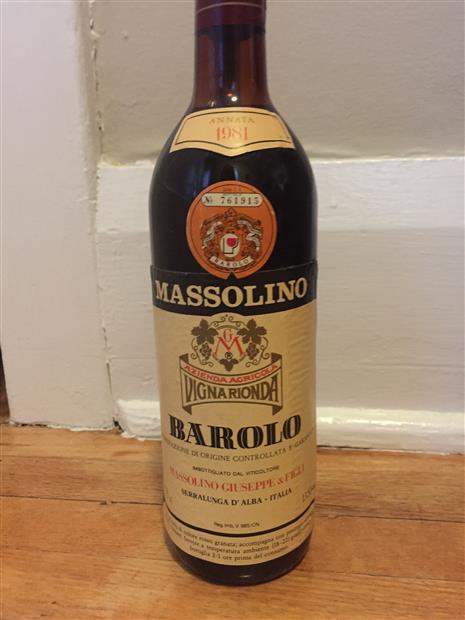
External search
Google (images)
Wine Advocate
Wine Spectator
Burghound
Wine-Searcher
Vintages
2017
2016
2015
2014
2013
2012
2011
2010
2009
2008
2006
2002
2001
2000
1988
1981
1980
1979
1978
1976
Show more
From this producer
Show all wines
All tasting notes
|
| Drinking Windows and Values |
| Drinking window: Drink by 2026 (based on 2 user opinions) |
| Community Tasting History |
| Massolino Producer website
U.S. Importer (Addt'l Info)
Source: VinConnect (VinConnect.com)
Established in 1896, by Giovanni Massolino, the winery has been dedicated to the production of great wines from the Langhe area of Piedmont for four generations. It was Giovanni’s son Giuseppe, one of the founders of the Consortium for the Defense of Barolo and Barbaresco, to construct the cellar located in Serralunga d’Alba, one of the most important villages in the production of Barolo DOCG. Giuseppe’s sons, Giovanni and Renato, divided the responsibility for the vineyards and cellar management, also acquiring some of the most prestigious cru vineyard sites in Serralunga d’Alba. Giovanni’s sons Franco and Roberto, both winemakers, joined the family business in the nineties and oversee the production.
The Massolino winery produces about 120,000 bottles each year, including Chardonnay, Barbera d’Alba, Nebbiolo d’Alba, Moscato d’Asti, and Barolo. The winemaking style is classically ‘traditional,’ as evidenced by the use of cement fermentation tanks and large Slavonian oak casks for ageing, however more modern techniques and technologies are also employed resulting in incredibly clean, elegant wines, perfectly respecting the characteristics of the autochthonous grape varieties and the territory. Over the years, the name Massolino has become synonymous with robust, concentrated and well-structured Barolo, celebrated around the world.
Massolino produces one classic Barolo and, with the addition of the most recently acquired vineyard in Castiglione Falletto, four Cru Barolo wines: Parussi, Parafada, Margheria, and Vigna Rionda.
“As a family tradition we search for the highest quality with full respect for the environment and implement everything necessary to produce wines which express the characteristics of our wonderful land.”
– Franco MassolinoNebbioloNebbiolo is a red grape indigenous to the Piedmont region of Italy in the Northwest. The grape can also be found in other parts of the world, though they are not as respected.
Nebbiolo is often considered the "king of red wines," as it is the grape of the famed wines of Barolo DOCG, Barbaresco DOCG, and Roero DOCG. It is known for high tannins and acidity, but with a distinct finesse. When grown on clay, Nebbiolo can be very powerful, tannic, and require long aging periods to reach its full potential. When grown on sand, the grape exhibits a more approachable body with more elegant fruit and less tannins, but still has high aging potential.
"Nebbiolo" is named for the Italian word, "nebbia", which means "fog", in Italian and rightfully so since there is generally a lot of fog in the foothills of Piedmont during harvest.
Nebbiolo is a late-ripening variety that does best in a continental climate that boasts moderate summers and long autumns. In Piedmont, Nebbiolo is normally harvested in October.
More links:
Varietal character (Appellation America) | Nebbiolo on CellarTrackerItaly Italian Wines (ItalianMade.com, The Italian Trade Commission) | Italian Wine Guide on the WineDoctorPiedmont Vignaioli Piemontesi (Italian only)
On weinlagen-infoLanghe Consorzio di Tutela Barolo Barbaresco Alba Langhe e Roero | Union of Producers of Albese Wines (Albeisa)BaroloRegional History:
The wines of Piedmont are noted as far back as Pliny's Natural History. Due to geographic and political isolation, Piedmont was without a natural port for most of its history, which made exportation treacherous and expensive. This left the Piedmontese with little incentive to expand production. Sixteenth-century records show a mere 14% of the Bassa Langa under vine -- most of that low-lying and farmed polyculturally. In the nineteenth century the Marchesa Falletti, a frenchwoman by birth, brought eonologist Louis Oudart from Champagne to create the first dry wines in Piemonte. Along with work in experimental vineyards at Castello Grinzane conducted by Camilo Cavour -- later Conte di Cavour, leader of the Risorgimento and first Prime Minister of Italy -- this was the birth of modern wine in the Piedmont. At the heart of the region and her reputation are Alba and the Langhe Hills. This series of weathered outcroppings south of the Tanaro River is of maritime origin and composed mainly of limestone, sand and clay, known as terra bianca. In these soils -located mainly around the towns of Barolo and Barbaresco -- the ancient allobrogica, now Nebbiolo, achieves its renowned fineness and power.
map of Barolo DOCG
An interesting thread on Traditional vs. Modern Barolo producers:
https://www.wineberserkers.com/forum/viewtopic.php?f=1&t=106291 |
|




